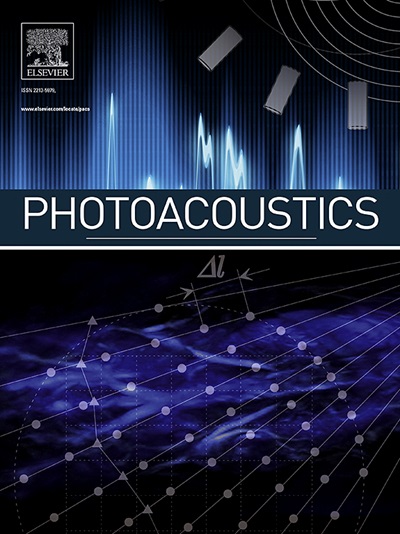Optical synchronous signal demodulation-based quartz-enhanced photoacoustic spectroscopy for remote, multi-point methane detection in complex environments
IF 7.1
1区 医学
Q1 ENGINEERING, BIOMEDICAL
引用次数: 0
Abstract
We present a novel optical synchronized signal demodulation (OSSD) method applied in quartz-enhanced photoacoustic spectroscopy (QEPAS) for remote gas sensing. Using 1 % of the laser source as an optical synchronization signal, kilometer-scale remote gas detection was achieved, overcoming the challenges of long-distance real-time detection in complex environments with conventional QEPAS. A time-sharing OSSD-QEPAS system for sewer methane detection was subsequently developed. The system’s modulation depth was optimized, and the catalytic effect of water vapor on photoacoustic signals was validated, resulting in a CH₄ sensor achieving a detection limit of 445 ppb with a 300-ms averaging time, and an excellent linear dynamic range with a R2 = 0.999. To demonstrate the stability, robustness, and accuracy of the OSSD-QEPAS system, continuous methane measurements covering a 14-hour period at two different sewer locations on campus were performed.
基于光学同步信号解调的石英增强光声光谱技术用于复杂环境下的远程多点甲烷探测
提出了一种新的光学同步信号解调(OSSD)方法,应用于石英增强光声光谱(QEPAS)遥测气体。利用1 %的激光源作为光学同步信号,实现了千米尺度的远程气体检测,克服了传统QEPAS在复杂环境下远距离实时检测的难题。随后开发了用于下水道甲烷检测的分时OSSD-QEPAS系统。优化了系统的调制深度,验证了水蒸气对光声信号的催化作用,得到了445 ppb的检测限,平均时间为300 ms,线性动态范围为R2 = 0.999。为了证明OSSD-QEPAS系统的稳定性、稳健性和准确性,在校园两个不同的下水道位置进行了为期14小时的连续甲烷测量。
本文章由计算机程序翻译,如有差异,请以英文原文为准。
求助全文
约1分钟内获得全文
求助全文
来源期刊

Photoacoustics
Physics and Astronomy-Atomic and Molecular Physics, and Optics
CiteScore
11.40
自引率
16.50%
发文量
96
审稿时长
53 days
期刊介绍:
The open access Photoacoustics journal (PACS) aims to publish original research and review contributions in the field of photoacoustics-optoacoustics-thermoacoustics. This field utilizes acoustical and ultrasonic phenomena excited by electromagnetic radiation for the detection, visualization, and characterization of various materials and biological tissues, including living organisms.
Recent advancements in laser technologies, ultrasound detection approaches, inverse theory, and fast reconstruction algorithms have greatly supported the rapid progress in this field. The unique contrast provided by molecular absorption in photoacoustic-optoacoustic-thermoacoustic methods has allowed for addressing unmet biological and medical needs such as pre-clinical research, clinical imaging of vasculature, tissue and disease physiology, drug efficacy, surgery guidance, and therapy monitoring.
Applications of this field encompass a wide range of medical imaging and sensing applications, including cancer, vascular diseases, brain neurophysiology, ophthalmology, and diabetes. Moreover, photoacoustics-optoacoustics-thermoacoustics is a multidisciplinary field, with contributions from chemistry and nanotechnology, where novel materials such as biodegradable nanoparticles, organic dyes, targeted agents, theranostic probes, and genetically expressed markers are being actively developed.
These advanced materials have significantly improved the signal-to-noise ratio and tissue contrast in photoacoustic methods.
 求助内容:
求助内容: 应助结果提醒方式:
应助结果提醒方式:


